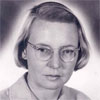Miller Goss
 Miller Goss (NRAO) and Richard X. McGee (CSIRO, retired) are pleased to announce the publication of “Under the Radar: The First Woman in Radio Astronomy, Ruby Payne-Scott” as a book in Springer’s Astrophysics and Space Science Library series. The book is also available as an e-book to institutions that have a Springer e-book subscription, and it will be launched at Sydney University on 25 November 2009. The book has 354 pages and 120 figures. Institutions that have a Springer subcription in the US and Canada can purchase a softcover edition at a substantial discount.
Miller Goss (NRAO) and Richard X. McGee (CSIRO, retired) are pleased to announce the publication of “Under the Radar: The First Woman in Radio Astronomy, Ruby Payne-Scott” as a book in Springer’s Astrophysics and Space Science Library series. The book is also available as an e-book to institutions that have a Springer e-book subscription, and it will be launched at Sydney University on 25 November 2009. The book has 354 pages and 120 figures. Institutions that have a Springer subcription in the US and Canada can purchase a softcover edition at a substantial discount.
Payne-Scott (1912-1981) was an eminent Australian scientist who made major contributions to the World War II radar effort of the Council for Scientific and Industrial Research (1926-1949) Division of Radiophysics from 1941 to 1945. In late 1945, she began pioneering radio astronomy efforts at Dover Heights in Sydney and continued her groundbreaking activities until 1951. Payne-Scott most probably carried out the first interferometer observations in radio astronomy at sunrise, 26 January 1946 at Dover Heights, using an Australian Army radar as a radio telescope. A ‘sea-cliff’ interferometer was used at an eastern facing 100-meter cliff at Dover Heights, Sydney.
Payne-Scott made remarkable contributions to the theory of radio interferometry and collaborated with Joseph Pawsey in the first formulation of the concept of aperture synthesis in mid 1946. She was also an active collaborator with B.Y. Mills, Chris (W.N.) Christiansen, Alec Little and John Bolton. A well-known image of Payne-Scott along with Little and Christiansen is in Figure 1(Chris is to the right). This image was taken in about 1950 at the Potts Hill Reservoir field station in Sydney; Payne-Scott and Little developed the first swept lobe interferometer to follow the motions of solar radio bursts of Type II and Type IV at 100 MHz. Payne-Scott played the key role in elucidating the properties of the ubiquitous Type III solar radio bursts; from the short time delays observed (high frequencies observed initially, lower frequencies later), she inferred the slightly relativistic velocities of the exciters of these events in the solar corona.
The book also summarizes the conflicts that Payne-Scott had with the CSIRO hierarchy due to the fact that she was a woman. She was in conflict the CSIRO administration when her marriage from 1944 was discovered in 1950. Payne-Scott left CSIRO when her son was born in late 1951. She also protested the wage inequality of women in the post World War II era. Other aspects of her life that are described are her membership in the Communist Party of Australia, her passion for bush walking and the success of her two famous children. The authors have attempted to place her scientific achievements and the discrimination she faced in a modern context.
 Miller Goss (NRAO) and Richard X. McGee (CSIRO, retired) are pleased to announce the publication of “Under the Radar: The First Woman in Radio Astronomy, Ruby Payne-Scott” as a book in Springer’s Astrophysics and Space Science Library series. The book is also available as an e-book to institutions that have a Springer e-book subscription, and it will be launched at Sydney University on 25 November 2009. The book has 354 pages and 120 figures. Institutions that have a Springer subcription in the US and Canada can purchase a softcover edition at a substantial discount.
Miller Goss (NRAO) and Richard X. McGee (CSIRO, retired) are pleased to announce the publication of “Under the Radar: The First Woman in Radio Astronomy, Ruby Payne-Scott” as a book in Springer’s Astrophysics and Space Science Library series. The book is also available as an e-book to institutions that have a Springer e-book subscription, and it will be launched at Sydney University on 25 November 2009. The book has 354 pages and 120 figures. Institutions that have a Springer subcription in the US and Canada can purchase a softcover edition at a substantial discount.